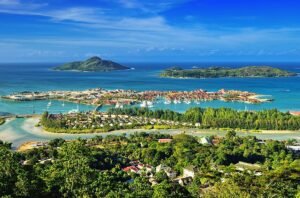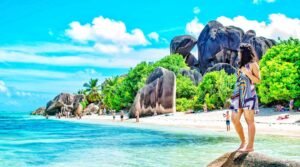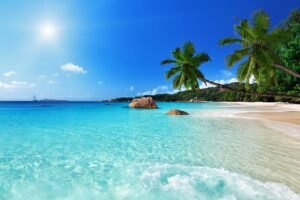


THE BEST PLACE TO VISIT IN SEYCHELLES: TOP HIDDEN GEMS & HONEYMOON SPOTS 2025
“We drifted off the beaten path, into a secluded cove where the only footprints in the sand were ours—and time seemed to fold in on itself.”
When someone asks, “What is the best place to visit in Seychelles?”, part of the charm lies in the fact that there is no single answer. The Seychelles archipelago, with its more than 100 islands, is a mosaic of landscapes—each island, each beach, each hidden trail, and each reef has its own voice, its own personality. But for the romantic traveler or honeymooner, there are places whose whispers feel as though they were reserved just for two.
1. Setting the Stage: Why Seychelles?
Seychelles conjures images of impossibly turquoise seas, sugar-white sands, and granite boulders rising like sculptures from the shoreline. But more than that, it is a living laboratory of island evolution: endemism, marine conservation, and the tension of tourism and ecology.
1.1 Geography, Climate & Access
The Republic of Seychelles lies in the Indian Ocean, northeast of Madagascar and east of East Africa. The archipelago comprises 115 islands, divided broadly into the Inner (granitic) islands and the Outer (coralline or atoll) islands. The most visited islands include Mahé, Praslin, and La Digue (all Inner Islands).
The climate is tropical and moderated by trade winds. The dry season (around May to October) tends to bring clearer seas and calmer conditions—a preferred time for snorkeling, diving, and beach days. The wetter months (November to March) can bring heavier rainfall and stronger winds, but the islands remain green and vibrant year-round.
From many international gateways (Dubai, Addis Ababa, Nairobi, Paris, etc.) you can reach Mahé’s Seychelles International Airport (SEZ), which serves as a hub for both main island access and onward inter-island connections (by boat or small plane).
1.2 Biodiversity & Conservation
What makes Seychelles more than just a beach destination is its rich biodiversity. Endemic species—such as the famed coco de mer palm, the Seychelles black parrot, and giant Aldabra tortoises—offer a deeper layer of wonder. The National Botanical Garden of Seychelles on Mahé preserves many endemic taxa and is a living conservation and research center. Wikipedia
More recently, a survey on Aride Island counted nearly 2,913 Wright’s gardenia trees—the largest census to date—signaling a resurgence in one of the rarest scented trees, thanks to invasive species removal and conservation efforts. The Guardian
Thus, as a visitor, you’re not merely witnessing postcard landscapes—you are engaging, even peripherally, in a fragile ecological balance.
2. Honeymoon Vision: What Makes a Spot Ideal for Lovers?
Before we list specific places, let us pause and define what makes a place special for a honeymoon—especially when choosing among so many.
-
Seclusion & privacy: Even in paradise, intimacy matters. A beach or villa where other tourists rarely intrude makes for a deeper shared experience.
-
Natural beauty & photogenic settings: Soft light, gentle waves, sculpted boulders, hidden coves, forested hills—it should feel like a dream.
-
Romantic experiences: Sundown catamaran cruises, underwater adventures together, candlelit dinners on the sand, couples’ spa rituals.
-
Easy but meaningful access: A romantic spot should be reachable (boat, hike, or short drive) without undue stress, but far enough to feel like an escape.
-
Ecological and cultural depth: To move beyond surface luxury—some nature walks, cultural immersion, local cuisine—makes the honeymoon richer.
With these criteria in mind, I take you on a journey through the best places to visit in Seychelles in 2025.
3. Mahé Island: The Grand Portal and Hidden Corners
Mahé, the largest and most populated island in Seychelles, is often the entry point for visitors—and yet it still holds hidden corners for those willing to explore beyond the main roads.
3.1 Beau Vallon to the North: Familiar, but With Secrets
Beau Vallon is often the go-to beach on Mahé: broad, sandy, with water sports, cafés, and a lively pulse. For honeymooners, it can be a comfortable first stop—easy, scenic, safe. From there, side trips lead to hidden coves, reef fringes, and sunset viewpoints.
One such lesser-visited stretch is Anse Major, accessible by a hiking trail (about 3–4 km from the trailhead near Bel Ombre). This trail traverses forest and ridge, rewarding hikers with a deserted beach where snorkeling, paddling, and quiet sunbathing beckon.
Another gem is Île Cachée (Hidden Island). Just off Cerf Island in the St. Anne archipelago, at low tide you can walk from Cerf to Cachée (around 100 m) across sand flats. At high tide, boats can ferry you. The islet has shallow waters, coral patches, and seabird nesting—perfect for a morning escape. Wikipedia
3.2 Morne Seychellois and Mont Fleuri: Hills above Sea
Escape the beaches and you’ll find cooler air and dramatic vistas in the mountainous interior. Morne Seychellois National Park covers over 20 km², with trails leading to viewpoints over coastal panoramas and forested valleys. A hike to Morne Blanc or Morne Blanc via the Trois Frères ridge gives you sweeping views over Mahé’s east and west coasts.
Near Victoria, the National Botanical Garden (in Mont Fleuri) offers an accessible botanical sanctuary. You can walk among palms, ferns, exotic fruit trees, and indigenous flora, while guides share insights into Seychellois botany and conservation. Wikipedia
3.3 Victoria: The Smallest Capital with Big Character
Victoria, the capital of Seychelles, is sometimes dismissed by travelers as simply a gateway. But step into its streets, especially the Sir Selwyn Selwyn-Clarke Market (often called Victoria Market), and you’ll find vibrant local life: fresh fish, tropical fruits, spices, Creole crafts, and color. (Note: as of early 2025, the market is under renovation and temporarily relocated to a former STC supermarket in Victoria.) Wikipedia
Don’t miss the clock tower, colonial buildings, the Seychelles Natural History Museum, and strolls along the harborfront. A side trip down to Anse Royal or Anse Intendance can reveal quiet stretches and surf breaks less frequented by crowds.
3.4 Hidden Beach Corners: Intendance’s Drama & Beyond
On Mahé’s south coast lies Anse Intendance, a dramatic stretch where seas can be wild. It’s less suited for full swimming at times, but excellent for romantic walks, wild beauty, and dramatic surf photography. Visitors occasionally spot turtle tracks and nesting activity on certain parts of this south shore. The Times (2025) names Anse Intendance among the standout beaches of the Seychelles. The Times
Further afield, Baie Lazare and Anse Soleil offer quiet coves, snorkeling, and often cafés with ocean views. The subtle contrast between the manicured resorts and these more understated bays gives you a deeper feel for Mahé’s soul.
4. Praslin Island: A Garden of Eden for the Senses
Praslin is the archipelago’s second most visited island, and for good reason. It balances beach perfection with rainforest mystique and offers honeymooners some of the most iconic landscapes in the Indian Ocean.
4.1 Beaches of Sublime Stillness
-
Anse Lazio: Often ranked among the world’s best beaches, Anse Lazio lies on the northwest of Praslin. The waters are calm, the sand powdery, and the backdrop of massive granite boulders frames every photograph. Wikipedia
-
Anse Georgette: Slightly more secluded and less trafficked, Anse Georgette boasts a pristine coastline edged by Takamaka trees and rock formations. It’s a true hidden gem, preserved in its natural state. Wikipedia
Between these two, as tide, wind, and season dictate, honeymooners often find that their “best place” is whichever cove they find themselves in on a quiet late afternoon.
4.2 Vallée de Mai: The Primeval Forest & Coco de Mer
One cannot leave Praslin without experiencing Vallée de Mai, a UNESCO World Heritage Site. Inside this forest lies the legendary coco de mer palm—the world’s largest seed. The forest feels ancient: shafts of light pierce dense crown canopies, ferns and orchids abound, and endemic birds (like the Seychelles black parrot) flit among the foliage.
Walking through Vallée de Mai, guides will share stories about local myths (e.g. fertility legends around the coco de mer) and point out rare species. For many couples, the moment they emerge from forest shade into a clearing, seeing the coconuts swaying above, becomes a quintessential memory of Seychelles.
4.3 Curieuse, Cousin, and Aride: Neighboring Islands of Wonder
From Praslin, boat excursions can take you to nearby isles that magnify the sense of remoteness.
-
Curieuse Island: Known for its population of giant tortoises, mangrove ecosystems, and coral reefs. A walking trail runs through the island interior, and along the coast you’ll find tidal flats, biodiversity, and quiet beach enclaves. The island was once used as a leper colony—there’s a small museum and historical remnants as well. The Times
-
Cousin Island: Managed as a nature reserve, Cousin is a sanctuary for birds, sea turtles, and rare plants. Many tours focus on ecological education and minimal impact.
-
Aride Island: A small granite island dedicated to conservation, especially seabird and plant restoration. Because of its ecological focus, visits are more limited and often accompanied by naturalist guides.
For romantic couples who value both beach serenity and wildlife, combining Praslin’s beaches with a curated day trip to these islets is a winning formula.
5. La Digue: Romance in Slow Motion
La Digue is the “small island where time slows.” With no cars (mostly bicycles and the occasional ox cart), it embodies a quiet elegance and natural intimacy that few places can match.
5.1 Anse Source d’Argent & Coastal Poetry
Arguably Anse Source d’Argent is among the most photographed beaches in the world—and for good reason. The interplay of gentle surf, white sand, and layered granite boulders, accented by coconut palms, gives it an almost surreal compositional beauty. Many honeymoon photographs here grace brochures and magazines.
Yet even here, early mornings or off-peak days bring the feeling of solitude. Visitors often find that the truly magical moment is when you stand knee-deep in water at dawn, with soft light and virtually no one else around.
5.2 Hidden Trails, Secret Beaches, and Veuve Reserve
-
Anse Cocos: Reached by a forest hike (~30–45 minutes) from Grand Anse, this secluded bay feels like your private beach. Few visitors make the trek, and when they do, they’re rewarded by a pristine cove often devoid of people.
-
Nid d’Aigle viewpoint: A moderately strenuous climb (~1–2 hours depending on pace) gives panoramic views of La Digue, Praslin, and the Indian Ocean beyond. Punishing at times, its reward is a sweeping, romantic vista.
-
Veuve Nature Reserve: Home to the rare Seychelles black paradise flycatcher (locally called “Veuve”), this reserve lets you appreciate La Digue’s forest interior in a mindful way.
La Digue’s charm lies in its very modest scale: you can bike from beach to beach, stop for a smoothie under a palm, pause at vanilla plantations, and live at island tempo.
6. Outer Islands & Lesser-Known Gems
To escape the circuits of typical travelers, look outward—toward islands less visited but brimming with romance and natural wonder.
6.1 Desroches Island: Private Island Dream
Desroches is among the most secluded (yet luxurious) islands of Seychelles. The whole island is surrounded by 14 km of white beaches, and it is often described as place where luxury meets wilderness. Many of its beaches feel like personal retreats. Planet Escape
Couples can cycle across the island, snorkel across reef heads, watch manta rays, or simply lounge where waves lap without interruption. The sense is that the island belongs only to you (and the sea).
6.2 Alphonse & Bijoutier: Remote Atolls with a Conservation Heart
Alphonse Island (in the Outer Islands) is emerging in hotspot lists. The resort there emphasizes conservation, with pristine coral reef systems, abundant marine life, and sustainable operation. The Times
Bijoutier—an islet near Alphonse—serves as a bird and turtle sanctuary and is often included in boat excursions. These remote atolls, far from the crowds, offer an elemental romance: sky, stars, sea, silence.
6.3 Remire Reef & Surrounding Waters
Remire Reef lies about 240 km from Victoria, in the Outer Islands. While there is no landmass on the reef itself, it provides a marine stage of clarity, depth, and coral topography. Wikipedia
For couples deeply drawn to underwater exploration, day trips or live-aboard arrangements that reach Remire or its neighboring submerged formations can be unforgettable. Just picture snorkeling over reef edges where fish swirl beneath you and no echo of boats disturbs the silence.
7. Putting It Together: Sample Romantic Itineraries for 2025
Here are a few sample itineraries structured to help you experience multiple facets of Seychelles—beach, forest, island hopping, and secluded romance.
7.1 Seven-Night “Classic & Hidden Corners”
-
Days 1–2 (Mahé base): Arrive Mahé, rest in a beach villa near Beau Vallon. Explore Victoria, market, botanical garden, and Anse Major hike.
-
Days 3–5 (Praslin + Curieuse): Move to Praslin. Visit Vallée de Mai, Anse Lazio, Anse Georgette. Do a day trip to Curieuse (tortoises, snorkeling).
-
Days 6–7 (La Digue retreat): Ferry to La Digue. Bike to Anse Source d’Argent, hike to Anse Cocos, enjoy a sunset picnic, and return.
7.2 Ten-Night “Ultimate Honeymoon Escape”
-
Days 1–3 (Mahé immersion): Include a night or two in a hillside villa, spa treatments, forest hikes, and hidden coves like Île Cachée.
-
Days 4–6 (Praslin + islets): As above, but reserve a day for a boat trip to Cousin or Aride.
-
Days 7–8 (La Digue sanctuary): Slow days biking, snorkeling, reading by the shore, romantic dinners.
-
Days 9–10 (Outer Island luxury): Fly or sail to Desroches, Alphonse, or another outer island for undisturbed beach time, starry nights, and marine immersion.
7.3 Special-Interest Itineraries
-
For marine lovers: Focus on Outer Islands, reef exploration (Remire, Alphonse), night dives, manta ray sites.
-
For nature & forest lovers: Spend more time on Morne Seychellois, Vallée de Mai, Veuve Reserve, guided forest walks.
-
For budget/rustic romance: Choose guesthouses or boutique eco-lodges on La Digue, Mahé’s quieter bays, and self-guided hikes.
8. Practical Tips & Considerations (2025 Edition)
8.1 Entry, Visas & Permits
Most nationalities do not require a prior visa to enter Seychelles for short stays. Tourists typically obtain a visitor permit on arrival, provided they have a return ticket, proof of accommodation, and sufficient funds. Always verify based on your passport.
If you plan to visit outer islands, some require special conservation permits or advance booking. Be sure your travel agent or host can arrange any necessary approvals.
8.2 Transport Between Islands
-
Ferries: Reliable and scenic, the ferry network connects Mahé, Praslin, and La Digue.
-
Domestic flights: Some outer islands are accessible by small plane; schedule and weather matter.
-
Charter boats / catamarans: Useful for reaching smaller islets or customizing your route.
-
Transfers: Many luxury resorts offer private boat or helicopter transfers.
8.3 Accommodation Styles & Choices
Seychelles offers a broad range: from ultra-luxury private villas and overwater bungalows to boutique guesthouses and eco-lodges. Many resorts offer honeymoon packages (romantic dinners, couples’ massages, private picnics).
Always check recent reviews, and if seclusion is your priority, choose properties with private beach access or limited rooms.
8.4 Best Time to Visit
For calmer seas and good visibility, May through October is often ideal. That said, Seychelles rarely becomes inhospitable—December through March sees more rain, but also deeper green landscapes and occasional storms. The Knot+1
If your interest is in marine life (e.g. manta rays), check local seasonal windows—some species are more visible at certain times of year.
8.5 Health, Safety & Sustainability
-
Vaccinations: Check with travel health advisories for required or recommended vaccinations (e.g. yellow fever if arriving from endemic areas).
-
Water & sun: Use reef-safe sunscreen, stay hydrated, and avoid midday sun peaks.
-
Respect reef and wildlife: Don’t touch corals or harass animals; follow park rules.
-
Waste & energy: Opt for eco-friendly lodges, reduce plastic use, minimize your footprint.
-
Safety: Seychelles is relatively safe, but always secure your belongings, avoid remote trails alone after dark, and heed local advice on currents.
9. Deciding Your Best Place to Visit in Seychelles
By now, you may imagine a place that draws you: perhaps the forested shade of Vallée de Mai, the hush of Anse Cocos, the water’s clarity at Remire Reef, or the majestic simplicity of Alphonse’s desert-shore. That place, personal to you, is the best place to visit in Seychelles—not because it tops every list, but because it has stitched itself into your own story.
To crystallize your decision:
-
Pair a main island (Mahé or Praslin) with a “retreat day” on a quieter island or islet.
-
Balance beach and forest—don’t do all sand, or all hiking; the contrast enriches.
-
Move slower than you think—the magic in Seychelles often lies in waiting for tide shifts, light changes, and quiet moments.
-
Let local guides guide you off map—many of the hidden beaches and coves are known by fishermen or islanders, not guidebooks.
Ultimately, in 2025 Seychelles remains a treasure chest of hidden wonder. The “best place” is often the next quiet turn, the unmarked trail, the shaded boulder, the reef just beyond the breakers.
10. Further Research, Reading & External Links
-
For a deeper dive into Seychelles’ ecology and travel logistics, the official tourism site (e.g. seychelles.travel) is an excellent resource.
-
For comparative inspiration, see JetSetTrail’s The Best Places to Visit in Namibia: https://jetsettrail.com/the-best-places-to-visit-in-namibia/ (internal link)
-
For honeymoon resort reviews in Seychelles, check Tripadvisor’s list of romantic resorts. tripadvisor.com
-
For a narrative honeymoon guide, see TravelTriangle’s “Honeymoon in Seychelles 2025.” TravelTriangle.com


